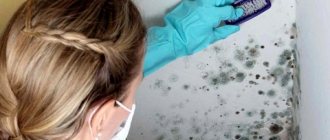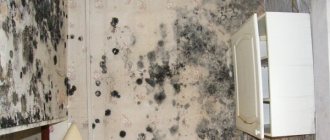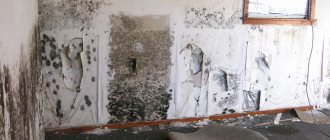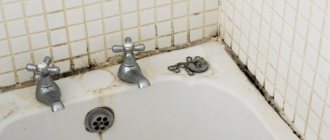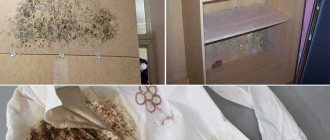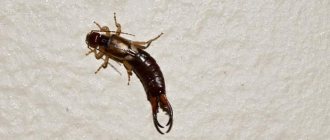How dangerous is black mold in the house for the human body and how to get rid of it is a complex question that worries many people. After all, some residents have to periodically deal with the appearance of black mold fungi in their own apartment or private house. It is extremely unpleasant to see colonies of fungi on products that have been lying on the shelf for a long time, or on the walls in the bathroom and other rooms.
This problem should be dealt with immediately, because mold provokes various diseases in family members. However, it is not possible to do this quickly in all cases, but you also cannot leave the problem without a solution. In order to find the best way to get rid of the scourge, we will look at the dangerous consequences of fungi, what types most often appear in apartments and how to deal with them yourself.
How dangerous is black mold in the house for the human body and how to get rid of it?
Groups of microorganisms in mold
Microorganisms in mold are divided into the following groups?
- The first group includes mold fungi. They affect building materials (concrete, stone) and surfaces treated with paint, plaster, and wallpaper. They come in a variety of colors, including black. They are clearly visible in contaminated areas, including on the walls of homes. At first they are located pointwise, and then form spots of points, gradually increasing in size. Some fungi from this group are able to glow in the dark.
- The second group consists of blue fungi. They have a detrimental effect on tree species, especially pine. Owners of wooden buildings should be attentive to this type of mold, protecting their buildings with preventive treatments.
- The third group is represented by putrefactive fungi. This is a brown microorganism that destroys all wood, without exception. Putrefactive changes appear as black (or other colored) stripes on wooden surfaces.
It belongs to the first group of microorganisms and has a detrimental effect on the human body. It is especially dangerous for older and younger age groups, people with weak immune systems and expectant mothers.
The harmful effects of mold on the human body
All organisms on the planet have their purpose and, despite the importance of the presence of black mold in the ecosystem, its presence in human life leads to harmful effects on the body; toxins released by microorganisms poison the respiratory tract and organs. Black mold feeds on dead organic matter and reproduces rapidly through spores. The rate of its growth cannot be controlled.
The health effects from airborne and direct contact are equally dangerous. If you don’t put all your efforts into destroying it, the consequences of fungal damage to walls for residents can be:
- allergy;
- asthma;
- dermatitis;
- rhinitis;
- bronchitis.
- conjunctivitis.
Black fungi can cause tuberculosis, suffocation and many other problems. To protect yourself from their effects, you must initially not neglect prevention, not giving microorganisms a single chance to settle in the house.
A kind of inhaler that is becoming increasingly popular
Modern liquids are characterized by a huge variety of tastes and aromas. When inhaling vapor, the smoker receives a so-called “throat hit”, the intensity of which depends on the amount of dissolved nicotine - it is this feature that allows many addicted people to consider vaping a type of replacement therapy and leads to the misconception that electronic cigarettes can be used as a method of treating nicotine addiction.
People believe that the harm of vaping without nicotine is minimal. However, the vapor contains not only a narcotic substance.
Symptoms of diseases of the human body
The problems arising from fungal exposure are many and varied; The initial symptomatology of a toxic disease is considered to be an allergy to mold in the form of a reaction of the human body to cold or dust. It is necessary to carefully assess the quantity and quality of symptoms and take appropriate measures to eliminate the microorganism, without ignoring them.
Other signs of the consequences of contact are: lack of air, difficulty breathing, sore throat. Frequent headaches, runny nose and weakness should alert you. Allergic reactions are possible in the form of rashes on the skin, itching and swelling. Asthmatics may experience worsening of the disease
As a result of damage by mold formations, diarrhea occurs and the immune system weakens. Why is black mold dangerous for humans? The fact that after the initial symptoms, in the absence of measures taken to eliminate it, serious problems begin, sometimes leading to cancer and death.
Ubiquitous pathogens
In principle, you say, nothing complicated. You just need to monitor the quality of agricultural products and not allow anything to become moldy. But therein lies the greatest catch of mold. We use it in everything from cheese (Penicillium spp. and Penicillium camemberti), soybean muesli bars (Rhizopus oligosporus), faux meat (Fusarium venenatum), black tea (I mean pu-erh), sherry (Botrytis cinerea), to soy sauce and miso paste (Aspergillus oryzae), and in dozens of other products. And, even if we didn’t do this, she is always with us. Its spores are in the air, on land and in water. Unchanged. Billions. Years. But what has changed, you ask?
Petri dish with mold. Named after the German bacteriologist Julius Richard Petri, assistant to Robert Koch.
For example, the industrial revolution gave birth to one of its offspring - mass housing construction. The first plasterboard factory opened in Rochester, Kent, UK in 1888, but truly stamped panels took over the market after the Second World War during the construction boom. Nowadays there are strange walls made of paper and gypsum plaster in every home. In every apartment. And this is the most striking example, mind you. The thing is that in a porous gypsum structure saturated with moisture, not only Stachybotrys, but almost any type of mold can grow on cellulose fibers. The drywall itself is often manufactured in violation of standards. The United States, for example, after Hurricane Katrina, China, which supplied drywall to many construction firms, faced multimillion-dollar lawsuits for violating standards and the presence of toxic compounds discovered during research into the consequences of the disaster.
In November 1994, Dr. Dorr Dearborn of Children's Hospital in East Cleveland, Ohio, USA, encountered an outbreak of a hitherto rare disease after a long rainstorm. On the same day, three newborn babies were admitted to him with bleeding in the lungs. When the children continued to arrive the next day, he sounded the alarm and called federal health officials. The disease received close attention. A couple of months later, an investigation led to black mold. The unusual downpour flooded several areas of the city and caused damage to old houses. Together, this led to the release of spores, causing bleeding and lung problems in newborns. Their immunity failed.
One of the last straws in the issue of mold settling in our homes was the fuel crisis of the 70s, after which we began to save energy resources, insulate houses, seal them, gradually bringing this art to perfection. We began to change the very environment around us, paying for comfort with health. Mold can and does live on whitewash, wallpaper, papers, books, fabrics, clothing, carpets, wood and boards. Any organic material, from a dead ficus on your balcony to dust in the air conditioner grid, is a fertile substrate for mushroom growth. We even changed the city's soil and air. The balance of spores in the natural environment and in megacities has changed - different levels of different types of spores. If in zonal soil it is Penicillium, then on your littered lawn near the entrance it is Aspergillus.
How to protect the human body from mold?
To protect the human body from mold, regularly conduct a thorough inspection of the premises to identify mold stains. If there is a hint of their appearance, immediately take action. Many recipes from available household substances are offered on websites to combat fungus.
The most common types of diseases acquired as a result of systematic exposure to mold-infected premises: Frequent influenza infections, bronchitis, asthma, pulmonary tuberculosis, allergies - are provoked by fungal and mold spores, which, when entering the human body, suppress his immunity, destroy beneficial microflora and actively reproduce in a favorable environment. Rheumatism is a disease that occurs as a result of constant contact with damp clothing, bed linen, upholstered furniture and other objects that are located indoors. The risk of exacerbations of these diseases especially increases in autumn, winter and spring.
Mold appears in the rooms, paint begins to peel off on the walls, plaster falls off, and traces of salt appear.
Human habitat without fungus
In St. Petersburg and the Leningrad region, a significant part of the residential and industrial environment is contaminated with fungus; mainly the premises of the first floors and basements, as well as the upper floors under the roof, are contaminated with this biological organism. Indoors, utility rooms and common areas are primarily contaminated: toilets, bathrooms, kitchens, dining rooms. It is not uncommon for fungus to appear in living rooms if there is high humidity due to poor heating, frozen walls, etc.
Infection with fungus occurs precisely due to high humidity when waterproofing is damaged, walls freeze, followed by condensation of water vapor. In addition, ineffective ventilation, penetration of polluted atmosphere into premises, and poor hygiene contribute to fungal infection.
In addition to the actual structures of the house, the fungus does not spare building materials, especially wooden ones. By releasing a special enzyme, the fungus converts cellulose into a soluble substance - glucose, and glucose oxidizes atmospheric oxygen into carbon dioxide and water, which leads to the destruction of the material. Infected wood is destroyed in 1-1.5 years.
It is noteworthy that the fungus concentrates first on the surface of the substrate (brick, stone, plaster), and then penetrates deep into it and destroys the material from the inside. Water, having low viscosity and the ability to dissolve various substances, performs transport functions and ensures the flow of nutrients into organisms and the removal of waste products from them. Waste products are mainly mineral or organic acids (sulfuric, acetic, citric, propionic, grape, etc.) - these compounds actively interact with the components of building materials.
The appearance of the fungus worsens the appearance of the structural elements of the room, cracks appear in the brickwork, reinforced concrete, and the plaster crumbles.
Even polymer products are not spared by the fungus, changing their shine; the fungus has also been found on storage media in computers.
Medical research on fungus
During a medical study of residential and industrial facilities, it was revealed that contaminated materials always contain fungi such as Aspergillis niger, Aspergllus fum, as well as Penicilium, Cladosporium, Scopulams, and less often Candida. In addition to the destructive effect of fungal spores in the air, they sharply worsen the sanitary and hygienic conditions of human stay in premises, which is still practically not taken into account by anyone, and the consequences are not assessed.
Mold is a microscopic numerous fungi that form a coating on the surface of an organic body, which causes spoilage of the product. Mold growth occurs immediately after the death of a plant or animal organism, first forming mold and then accumulations of bacteria. Molds begin to germinate and rapidly multiply, as a rule, where there are favorable conditions for this. On one moldy loaf of bread, for example, under a microscope you can detect billions of fungal spores, which are increasing in number every minute.
For mold to appear, favorable conditions are needed, such as high air humidity, a fairly high temperature, up to 30 degrees, and failure to maintain basic cleanliness. The influence of mold on the human body is quite great, since it is capable of spreading its microscopic spores through the air. For mold growth, room temperature, ineffective room ventilation and high humidity conditions are sufficient. Mold can attack surfaces such as concrete, wood, plaster, rubber, plastic and many others.
Noble mold infection
Noble mold often affects fruits and berries, which quickly become unusable because of it. However, in many countries such as Hungary, Germany and France, the most famous and delicious wines are produced thanks to this fungus.
Uses of blue mold
Blue mold has been known to the world for quite a long time, as it is an indispensable component of the use of marbled cheeses such as Stilton, Roquefort and Gorgonzola.
Uses of white mold
White mold is also added to cheese to add a new and unique flavor profile; used to produce famous cheeses such as Brie and Camembert. However, it should be remembered that only high-quality blue cheese has a positive effect on the human body, as it consists of a large number of microelements. But even such high-quality products are not recommended for use by children and pregnant women.
Mold Dangers to Pets and Houseplants
It turns out that mold is harmful not only to people, but also to other living inhabitants of a private house or apartment. We are talking about indoor plants and pets.
Thus, an insidious fungus more often than usual affects flowers that do not require intensive watering, and therefore are not able to absorb a lot of moisture at once (for example, cacti, aloe, violets, “money tree”, etc.) At the same time, mold can attack both soil and and the plant itself (in this case, the leaves begin to rot, turn black, and curl).
Mold can affect both the indoor plant itself and the soil in which it grows.
Of course, mold affects the plant negatively:
- Deteriorates soil quality. It disrupts water and mineral metabolism, acid-base balance.
- Death of the plant. The top layer of soil can turn into a crust that retains moisture and does not allow air to pass through. The roots begin to rot, then the branches and leaves die.
- Mold can “move” onto the windowsill, window frames, walls, and ceiling.
As for pets, if they inhale spores or tactile contact with mold, they may experience breathing problems (including pulmonary edema) and disruptions in the functioning of the nervous system. In case of severe poisoning, death cannot be ruled out.
If spores of certain types of mold enter the body of a weakened animal (for example, an old animal or a pet after an injury), then the fungus can affect internal organs.
The effects of mold on the human body
Exposure to mold is harmful to the human body because it produces and contains toxic compounds that are hazardous to health. A person can inhale mold spores with air, and they will settle in the lungs. Also, fungal spores easily get into food and are absorbed through the skin, which is why nails are checked in swimming pools for the presence of mold under them.
Sometimes after brushing your teeth, a specific taste appears in your mouth, this indicates that fungus has appeared on the toothbrush and it should be replaced immediately. Mold causes allergic reactions in children, since the children's immune system is not yet strong enough. Since everyone's susceptibility to mold fungi is different, the consequences of infection can also vary significantly. Elderly people and patients who have undergone chemotherapy and are taking antibiotics are especially susceptible to severe illness due to exposure to mold.
Diseases resulting from mold exposure:
- Pneumonia;
- Sinusitis;
- Skin rashes;
- Dry cough;
- Stomach upset;
- Nosebleeds;
- Headache.
The cause of these diseases is sometimes very difficult to diagnose and difficult to cure. Many types of mold that surround us have pathogenic forms, long-term exposure to which can cause internal bleeding, liver and kidney damage, as well as pulmonary emphysema. Severe mold poisoning of a person leads to the development of mycosis, which is diagnosed in various laboratories and allergy centers using test tests.
What to do if mold appears on food
As a rule, mold can appear suddenly and anywhere; it can especially often be found in your own refrigerator on food. Most often, mold appears on baked goods, and upon discovering such a surprise, many simply cut off the mold-affected area, mistakenly considering the rest of the bread to be edible. Basically, no one even thinks about how safe such actions can be for the health of the whole family. So what should you do with moldy bread?
Modern scientific research has shown that dairy products and flour products affected by mold should definitely be thrown away entirely, since they have a porous structure through which mold spreads calmly and unhindered, penetrating the entire depth of the product. However, this does not apply to hard cheese; the mold that has formed on it can be carefully cut off with a knife, and the remaining part can be used to prepare dishes such as pizza.
Quite often, mold appears on jam, which is a pity to throw away. It is a mistake to believe that such formations can somehow resemble penicillin. This is not true, because noble mold, which is used to make healthy products, is grown in special conditions and undergoes the necessary preparation, and the mold that affects our products in the refrigerator contains a great variety of toxic substances that negatively affect the human body.
First aid for mold poisoning
If mold does enter the body, it is recommended that in case of poisoning, immediately consume activated carbon, 1 tablet per 10 kg of body weight. With any, even the most minor poisoning, the liver is primarily affected, so you should take this problem seriously. If a sufficiently large amount of moldy product is eaten, it is advisable to rinse the stomach with a weak solution of potassium permanganate or use a medication that has a restorative effect. The best option in case of mold poisoning is to contact a doctor in a timely manner, who will help you correctly carry out the procedure for removing toxins from the body.
I was faced with a problem that was not very serious at first glance, suspicious dark spots on the walls. But if you look deeper, such stains that occur in basements, bathrooms or living rooms can lead to significant problems in the future. These are mold fungi, a sign of high humidity and poor ventilation in the room. Mold is a colony of a single-celled fungus that develops from spores that are constantly present in the air in a “preserved” state in huge quantities. The spores “wake up” for intensive reproduction as soon as favorable conditions appear for this: increased humidity and warmth.
Deadly Variety
Let’s say you don’t have a compost heap in your office, at your dacha, or on your balcony. You haven’t had tuberculosis and you still have your own liver, and fresh fluorography hangs in a visible place - somewhere on the refrigerator. Let's fast forward to the territory of modern Ukraine in the early 1920s. At this time, an epidemic occurred here that claimed the lives of several thousand horses. Symptoms in horses included crusting and peeling of the lips, irritation of the mucous membranes of the nose, throat and mouth, difficulty swallowing, bleeding, nervous system damage and death. The time was difficult, the reasons could not be established. The epidemic began mysteriously and ended just as mysteriously.
Photograph of the first signs of damage in animals, early 20th century:
Since the 1930s, cases of similar epidemics among people began to be recorded, but of a completely different scale and horror. The first outbreaks appear in the Urals and Western Siberia. So, during the war, there was an outbreak of a disease called “septic tonsillitis” or scientifically - alimentary toxic aleukia. Characteristic symptoms were a decrease in leukocytes in the blood, high fever, necrosis in the oral cavity and pharynx, and hemorrhages on the skin. The mortality rate in some places exceeded 50%. Witnesses of the disease described apocalyptic scenes with profuse bleeding, when dozens of patients lay in blood-soaked beds and a sweetish smell of rot came from them. The incidence peaked in 1944, claiming tens of thousands of lives in an already devastated country. Several years later, the reasons were finally identified. They turned out to be two types of mold: Stachybotrys - in the case of horses, and Fusarium - in the case of sore throat. And 10 years later, scientists discovered the world of mycotoxins and, as they say, away we go.
Fusarium, translated from Latin - “spindle”. And, if Fusarium sporotrichoides, which affected grain reserves in the USSR, caused tens of thousands of terrible deaths, then, for example, Fusarium venenatum is produced industrially for use as food because it is rich in protein. This is what artificial meat is made from. Another 3-4 species can cause infections in the nails and cornea of the eye. Eating grain infected with sporotrichoides is dangerous primarily due to the trichothecene mycotoxins produced by the mold, and not by the mold itself. For “fusariums with.” this is the famous T2 mycotoxin, which, after its discovery, they are constantly trying to attribute to someone (us) in the context of the use of biological weapons, this is the Yellow Rain (not to be confused with golden rain) in Laos and Afghanistan (1975-1981), and deliveries to Iraq, and “ Desert Storm."
If you look at mycotoxin T2 more closely, the mechanism of action seems very, very interesting. A compound with the formula C24H34O9, once ingested with food, penetrates cells and overloads them with oxidative stress. Simply put, too many molecules with unpaired electrons (free radicals) are formed, and they “steal” these electrons from what is nearby, destroying everything, even DNA. After which the cell either decides that it is finished and initiates self-destruction (apoptosis), or necrotes (dies) due to damage. In both cases, you are also “ass”. Hence the symptoms. There were similar outbreaks in the USA, but with Fusarium Culmorum. This is a mold that prefers corn and produces vomitoxin, from the English. - “vomit.” When consumed, your main symptom is uncontrollable and uncontrollable vomiting. It's better than necrosis, but still not great. Most Fusariums help plants and live with them in symbiosis; they settle in the soil near the roots and help them feed and survive drought. But in the case of a harvest, they simply change their place of residence from roots to fruits and, due to violations of storage conditions, germinate, poisoning the food.
Soviet laboratory:
Stachybotrys chartarum is the same black mold on wallpaper, paper or books. In nature, it decomposes cellulose in the absence of direct sunlight and high humidity. It was first documented as a problem in the housing and communal services sector, already in 1837 in one of the houses in Prague by the Czech mycologist Karl Joseph Korda. Stachybotrys is no exception in the genus of toxic fungi - the Satratoxin-N it produces, although not considered a chemical weapon, is extremely dangerous for the life of macro-organisms like you and me. It is absolutely universal in terms of penetration into our carcass: you can inhale it, you can eat it, you can touch it and feel it - you will feel equally bad. Depending on the place of contact, you can get: rash, pain in the chest/breasts, headache, feeling tired, bleeding in the lungs, cough.
Causes of fungi (mold)
The main reason for the appearance of mold is the ideal conditions for the appearance and spread of such fungi: temperature +20°C (some varieties can grow at zero temperature or even below zero) and relative humidity above 95%. In general, there are not so few opportunities for creating living conditions for harmful fungi. This is, first of all, capillary suction of moisture along the walls of moistened foundations. This is especially common in old buildings due to the lack of waterproofing.
In modern houses, the most common cause of mold is the increased thermal conductivity of the corners and additional heat losses in the end rooms compared to ordinary rooms located inside the building, due to the increased area of the external walls facing the street. It is also necessary to say about one more circumstance specific to our country - the very early shutdown of heating in the spring and the delay in turning it on in the fall. This also creates favorable conditions for the development of fungus. And of course, the massive introduction of plastic window technology, insulating from noise and retaining heat, disrupts the processes of natural ventilation of rooms and contributes to the formation of high humidity.
Normal for a comfortable human existence is humidity in the range of 70% - 80%. If a space at home or a room has a high level of humidity (house plants, animals, frequent laundry in the presence of small children, cool rooms with high humidity outside, uneven heating of rooms, poor ventilation, etc.) moisture condenses in suitable places. Such places are future sources of the appearance and rapid proliferation of mold fungi.
Harmful of mold to human health.
Let us note: mold is dangerous not only and not so much for the building structure, but also harmful to human health. Once in the respiratory and circulatory system, spores can cause a number of diseases. In addition, when mold multiplies, it releases volatile organic compounds, which are responsible for a specific odor and are very harmful to health. The consequences may vary. First of all, these are difficult to diagnose and treatable allergic diseases of the skin (dermatoses, mycoses) and respiratory tract (runny nose, cough, even bronchial asthma). As well as diseases of the musculoskeletal system or joint-rheumatic, headaches of unknown origin, nausea, dizziness and even exhaustion. Children, elderly people and people with weakened immune systems are especially susceptible to this scourge.
How to protect yourself from mold “attack”?
To protect yourself from an “attack” of mold, you first need to establish the cause of the “headache” in specific places and consider measures to eliminate high humidity. At the same time, you need to know that heating and ventilation must function at the level of design standards, the walls of the premises must have thermal resistance strictly in accordance with the design, and heating devices must be correctly placed in the end rooms. Treat any small stains found with hydrogen peroxide or table vinegar as a first emergency measure.
Install only “hinged” plastic windows and ventilate the premises by opening the windows completely, try to install ventilated facades in the premises.
Do not close bathroom doors tightly, leaving room for temperature and humidity to equalize.
Treat contaminated surfaces with a special agent, if necessary, then to the level of the concrete (brick) surface.
Folk remedies that help in the fight against mold:
- The surface is treated with creosote;
- A solution containing 1-1.5 kg of sodium fluoride, or 1 kg of copper sulfate, or 1.5 kg of iron sulfate in 10 liters of water. You can add both iron and copper sulfate (0.5 kg each) to the solution at the same time;
- A solution containing 0.5 kg of copper sulfate and 1.5-2 liters of acetic acid in 10 liters of water;
- A solution containing 0.9 kg of borax, 0.4 kg of boric acid and 1.4 liters of table vinegar in 10 liters of water.
The prepared solution is heated to 50-70°C and sprayed or applied with a brush to those areas that are affected by the fungus. The wood is allowed to dry, and after a month the treatment is repeated; Anthracene oil penetrates deeply into the pores of the wood and completely destroys the fungus, however, after such treatment, the wood is well colored only after a few years. It is recommended to treat other affected building materials with copper sulfate, office glue or urea. However, folk remedies only temporarily stop mold growth.
As a result of exposure to constant moisture and heat, fungus may appear on the walls and ceiling. Of course, black mold is harmful to health, but not everyone thinks about it.
When arranging the interior of an apartment or private house, residents try to give it originality, but forget about serious problems. Thus, black mold not only spoils the appearance of the room, but also negatively affects the well-being of household members. We will discuss further why mold is dangerous for humans and what pathologies it causes.
Ways to combat mold
Even the presence of dense and massive plaque on the surface of walls, flooring and in the spaces under baseboards should not frighten apartment owners. First of all, you should prepare a respirator or a high-quality mask to protect the respiratory tract.
You will also need glasses and gloves. Next, the room is cleaned according to the following scheme:
- All visible plaque is carefully removed from the wall with a spatula or spatula. The removed particles of fungal colonies should be immediately packed in a plastic bag to avoid the spread of spores.
- A specialized solution with an antifungal effect is poured into a container with a spray bottle. Such drugs have sufficient concentration and can stop the development and cause death of pathogenic microorganisms.
Sometimes powerful oxidizing agents are used in everyday life, for example, classic bleach, acetic acid, concentrated citric acid.
Oxidizing agents destroy the tissues of the fungus, causing its death. As an alternative, vegetable oil can be used to coat the mold surface, preventing oxygen from entering.
How does mold spread?
Mold in an apartment is a special type of fungus that spreads through spores. This type of fungus can attack the walls of buildings with increased dampness. The largest amount of black mold can be seen on slopes near windows, since condensation most often accumulates there.
There are several types of fungus that negatively affect the human body:
- Aspergillus is a microorganism that spreads during repair work on building materials.
- Penicillus is a fungus that spreads on damp materials in the form of blue or green spots.
- Cladosporium is a microorganism that lives on fabrics and wood surfaces.
- Alternaria is a fungus that grows in moist environments in kitchens and bathrooms.
Fungal spores are invisible to the human eye and can only be detected under a microscope. They enter the room with clothing, pets, or during normal ventilation. It is almost impossible to completely protect yourself and your loved ones from mold.
However, the fungus affects the ceiling and walls if conditions are favorable for this. The optimal humidity level in a living space is considered to be 80%, and it is better not to exceed it. An increase in this indicator is the main factor influencing the development of the fungus. The moisture concentration in the room increases as a result of:
- lack of normal ventilation in an apartment or house;
- high room temperature in frosty weather, which leads to the formation of condensation;
- uneven heating of the living space;
- abundance of indoor flowers in the apartment;
- drying wet clothes in the bathroom.
Most often, fungus appears on apartment walls, ceilings, under window sills, behind cabinets, in the kitchen and bath, that is, places where moisture accumulates. Having noticed mold on your walls or in other places, you need to urgently deal with it before it causes serious harm to your household.
What is mold and why is it harmful?
The mold that we see in our homes is a fungus. It develops from a spore.
A spore is a microorganism protected by a durable shell. The mold that develops from it is a multicellular organism formed by long fibrous threads (hyphae). Moreover, it grows from the spore at high speed, “capturing” the surrounding surface.
A mold spore is a microscopic, single-celled capsule with a tough shell.
Nature has made sure that spores can withstand difficult conditions; they are carried with air currents and cling to objects. And for mold to begin to grow from this “capsule”, certain favorable factors are needed, which we ourselves create in our homes:
- Increased air temperature (many people like to warm themselves and turn on heaters).
- Increased humidity (for example, in a bathtub, where clothes are often dried for a long time, puddles remain on the floor after bathing, floor mats are not dried, etc.).
- Lack of access to fresh air (insufficient ventilation of premises).
Mold loves a moist environment and multiplies quickly there
Various types of mold can grow on almost any surface: concrete, wood, paper, fabric, food. The fungus especially likes to settle next to plastic windows, because condensation sometimes accumulates there. Over time, mold can destroy the walls, ceiling, and floor of a room.
Why is mold dangerous to the human body?
It is impossible to immediately sense the danger of mold, which is why it is called a “time bomb” for the human body. Initially, it does not affect human health, but with prolonged contact it causes serious illness. The harm to human health has been proven by numerous medical studies.
The effect of black mold in an apartment or private house occurs as follows:
- Toxic intoxication, which occurs as a result of fungus entering the digestive tract, which is accompanied by extremely unpleasant sensations (abdominal pain, diarrhea, nausea, vomiting or constipation).
- An allergic reaction is a process that occurs due to mold entering the mucous membrane of the nose, eyes or mouth. The cause of such reactions can be both dead and active fungi.
- Direct infection is very rare and occurs mainly in immunocompromised people.
As a rule, long-term presence of fungus on the ceiling and walls in an apartment leads to the development of serious pathologies:
- Mycoses and dermatoses are diseases of the skin that arise as a result of the settling of mold spores.
- Joint and rheumatic diseases in combination provoke a deterioration in general health, the development of headaches, drowsiness and weakness.
- Chronic diseases associated with irritation of the mucous membrane. This may be a chronic runny nose, inflammation of the mucous membranes of the eyes, or the development of a dry cough.
- Diseases that occur in the upper and lower respiratory tract, for example, bronchitis, pneumonia.
- Activation of cancer cells during prolonged contact of the fungus with the human body. As a result, malignant neoplasms may appear.
American scientists agree that fungal spores have a detrimental effect on children's bodies, causing exacerbation of asthma. In addition, they are a factor influencing the development of diseases of the cardiovascular system.
In order not to harm your health, it is necessary to properly and promptly combat black mold indoors, which we will discuss later.
How to treat clothes, books and furniture against fungus
Often, mold also affects clothing, for example, if it has been stored for a long time in an unventilated room or a closet that has not been opened for a long time.
You can first try to revive such a thing using folk remedies. There are many options here: soda, boric acid, hydrogen peroxide, fermented milk products, lemon juice in combination with salt, table vinegar, ammonia, turpentine, etc. You can try different methods until the desired result is achieved.
Folk remedies can help remove mold from fabric
If the fungus has already become deeply ingrained, then household chemicals that contain chlorine (again, Belizna, Domestos) will come to the rescue. However, you need to remember that for some fabrics such products are unacceptable (for example, for wool it is better to use Vanish).
Mold can also affect books. You can try to get rid of it. The spots are moistened with a solution of 2–3% formaldehyde, and the remaining pigmentation is bleached with hydrogen peroxide.
Mold on a book can be removed with a formaldehyde solution, and then the stains can be bleached with hydrogen peroxide
Before processing, you should place a regular sheet of white paper under the book page. You should wear rubber gloves when working with formaldehyde to protect your skin.
Video: removing mold from a book
Another way to remove mold from books is to rub the stains with boric acid and then dry the pages with an iron.
As for furniture, you need to understand that it is almost impossible to remove mold spores from upholstered furniture. If the upholstery can be washed and treated with antifungal agents, then the batting and foam rubber in the depths of the structure cannot be disinfected in any way. Unless, of course, you are ready to completely remove the upholstery and disassemble the structure, treat the wooden frame, fillers and upholstery separately, and then reassemble it from scratch.
How you can fight mold on textiles and shoes
- Repeated treatment with chlorhexidine,
- hydrogen peroxide,
- Miramistin,
- antifungal sprays such as Miko-stop.
- iron,
How to clean a moldy baby stroller
If mold has formed on a baby stroller during storage, of course, it is better to dispose of it or wash it well and use it only for an older baby, and not for a newborn.
Procedure:
- We remove the inner mattress and sides of the cradle, and the cover-cover. We wash them at the highest possible temperature according to the product passport or replace them with new ones (you can sew them yourself). When washing, add an oxygen stain remover such as Vanisha. After washing, dry and, if possible, steam, being especially careful in the seam area.
- We remove from the frame all the upholstery that can be removed. If it is secured with self-tapping screws or self-tapping screws, unscrew it. If it is possible to remove the bottom of the cradle, take it out. The fabric is usually synthetic, afraid of chlorine, but not afraid of oxygen agents and short steaming treatment. Soak for an hour, wash thoroughly, dry, and gently steam.
- We wash and treat the bottom of the cradle. Let's dry it.
- We wash the stroller chassis, dry it, and go through it with a steam cleaner.
- When everything is dry, we assemble the stroller.
Prevention of black mold development
To protect your home from the development of black mold and prevent the occurrence of serious diseases, you need to know a few simple rules of prevention:
- The room must be ventilated daily at least twice a day. Ventilation should be short but intense, that is, it is advisable to open windows and doors to the maximum. It is necessary to ensure that fresh air reaches the places most favorable for fungus - the bathroom, kitchen, attic and basement.
- You should not stay in poorly ventilated areas for a long time.
- The bathroom needs regular cleaning: washcloths must be dried, bathroom curtains must be constantly straightened and wiped.
- You should carefully monitor the serviceability of all plumbing fixtures, because constant leaks will also contribute to the spread of fungus.
- Linen should be hung out immediately after washing.
- When using a vacuum cleaner, you must open windows and doors wide. Ventilation will help level it out.
- When replacing a garbage bag, you need to wash and dry the bin.
- It is necessary to use an air conditioner to create a normal microclimate in the room.
Black mold in the house causes many diseases - from simple malaise to cancer pathologies. Therefore, when black, green or blue spots appear on the ceiling, walls or furniture, it is necessary to immediately deal with this problem. Today there are many special products that help get rid of fungus. And compliance with preventive measures will prevent its development.
Prevention after treatment
Dealing with harmful mold of any kind is a long process that requires a lot of labor. It is much easier to take measures to prevent the appearance of plaque on surfaces in the house:
- regularly ventilate all rooms, especially the bathroom and toilet;
- clean your home thoroughly and periodically disinfect it;
- monitor humidity, take an interest in this indicator in neighboring apartments, common basements;
- prevent the formation of condensation on windows, walls and doors;
- waterproof the basement if it is very wet;
- treat the surfaces with special antifungal agents;
- insulate the room when it freezes in the cold season.
